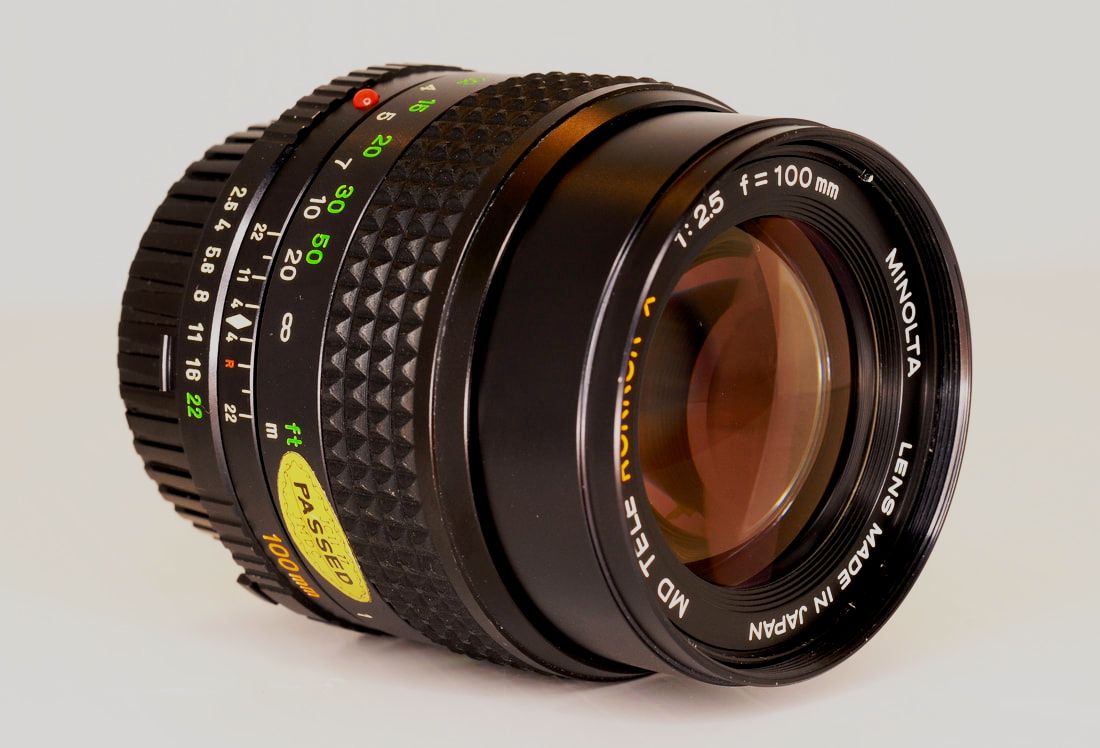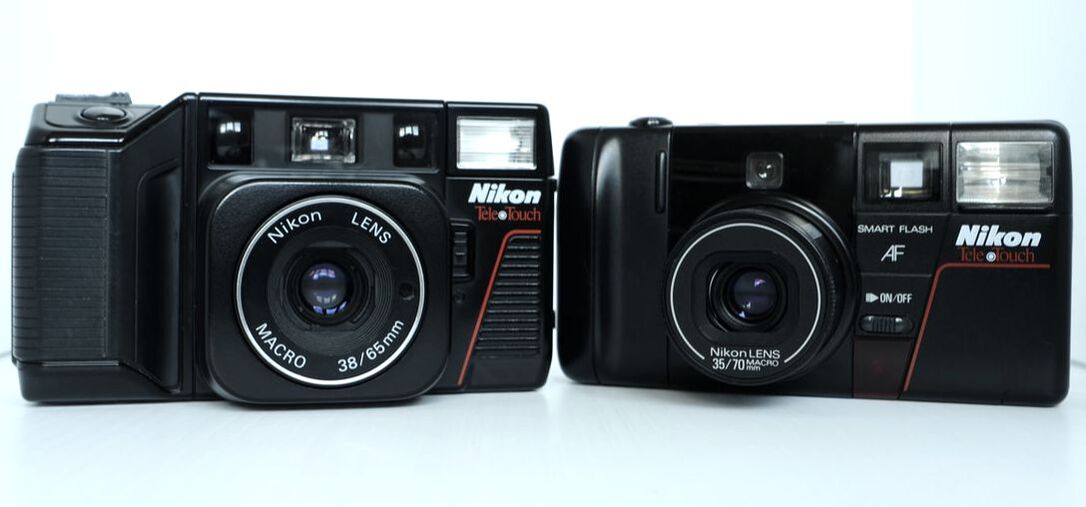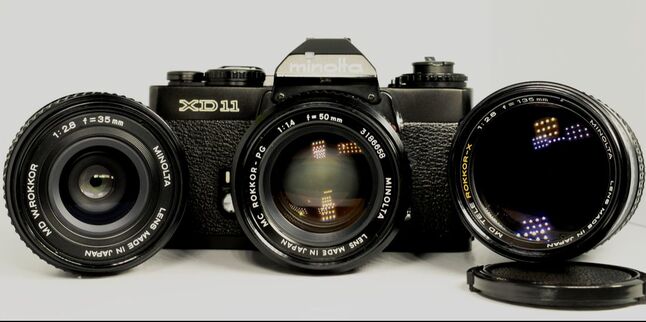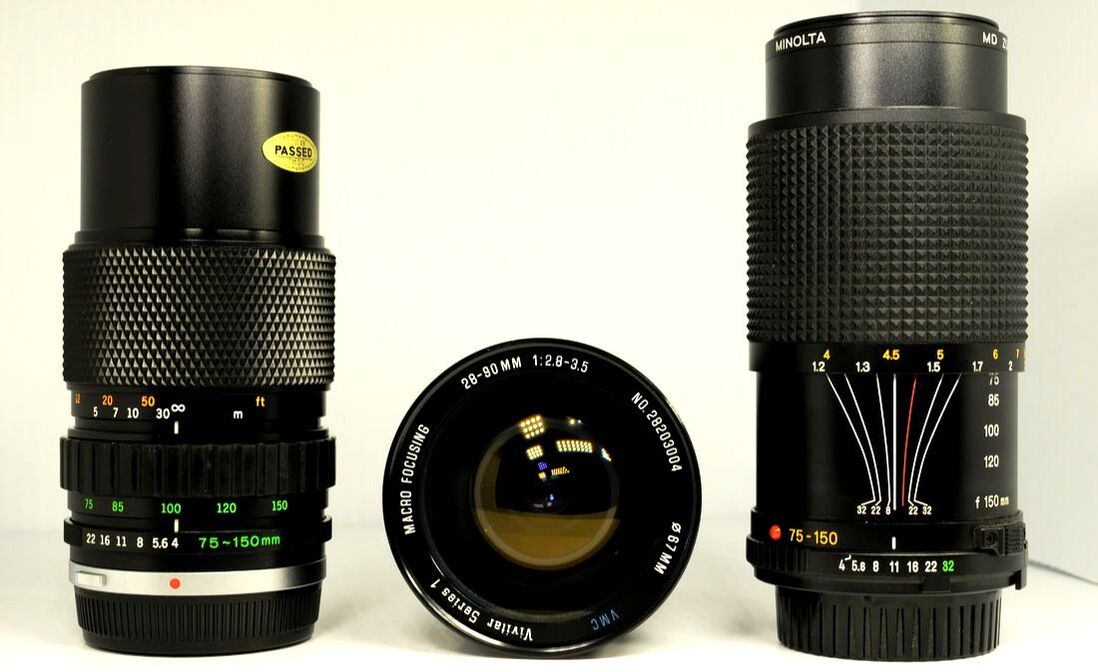|
The 58mm focal length is inextricably tied to the introduction of the 35mm SLR in the mid-1930s. This was due entirely to the physical difference in construction required by the mirror (the "reflex" part of the Single Lens Reflex designation) used for viewing the subject directly through the lens versus the then-standard rangefinder design. Because of the greater depth including the mirror in the optical path required, this entailed more distance between the rear of the mounted lens and the film plane, which is termed "back focus". The longer back focus of the SLR meant that the standard 50mm focal length rangefinder lenses of the day could not bring the rear focus node to the proper distance from the film plane if simply converted to the SLR mount (in this case, the Kine Exakta of 1936). By the mid-1960s, 50mm would become the standard for SLR lenses as optical designers were able to gradually overcome the design challenges presented by the SLR. In the meantime, the easiest way to overcome the back focus issue was to simply bump the focal length a bit to accommodate the extra back focus. And that is what Willy Merte of Zeiss did in developing the famous 58mm f/2 Biotar, released in 1938. The Biotar would set the bar for standard SLR lenses for the next 25 years, famously duplicated in the Helios 44-2, among others. Most manufacturers of SLR lenses followed Merte's lead by producing 55 to 58mm lenses, particularly for faster-than-f/2 maximum apertures. Minolta was no exception, and would, in fact, be the last holdout among the Japanese manufacturers when it came to adopting 50mm as its normal lens focal length. They introduced their fast 58/1.4 only three years after their first SLR, the SR-2, and supplemented it with a 58/1.2 seven years later. The 58/1.4 would remain in production until 1973, and the 58/1.2 until 1978, with both being replaced by 50mm lenses, accordingly. This is their story.
4 Comments
Updated Apr. 4, 2024 From its inception in late-1958, the Minolta SR system included at least one short telephoto of 100mm focal length, predating their first 85mm optic by over a decade. The last listing at B&H that I could find for the final New MD 100/2.5 iteration was from July 1994 (production had obviously ended back in the mid-'80s when the Alpha/Maxxum AF mount was introduced). So a successful (albeit fairly quiet) 35-year sales run in total for the manual focus Minolta 100mms. And yet, when talk turns to short Minolta manual focus (MF) telephotos, almost invariably, the 85/1.7 (first introduced in MC Rokkor form in 1970) tends to dominate the conversation. Not without reason, mind you; the 85/1.7 and its successor, the 85/2, are some of the finest examples of the type, regardless of brand. As a result, the 100s have slipped into the shadows somewhat. But they are definitely worth your consideration...so let's dive in. Updated Mar. 8, 2024 So where does our fixation with Top Ten Lists come from, anyways? Letterman? The Ten Commandments? Well, if you can't beat 'em.....Here, for your casual perusal, is a chronological consideration of ten important Japanese SLRs that pushed the development of such cameras forward for over 30 years. This is not to say that these are the 10 "top" or "best" SLRs of all time (far be it for me to be the arbiter of such things ;-)), and some may be less familiar than others, but all of them had an undeniable effect on the industry or market as a whole. Let's dive in :-). Updated Mar. 16, 2021 The Pentax K1000. The Minolta X-700. The Nikon F3. When it comes to naming the Japanese 35mm SLRs that remained in production the longest, those three models are at the top of most lists with both the Pentax and Nikon breaking the two-decade barrier (21 years for the Pentax and over 20 years for the Nikon to be more exact), and the Minolta clocking out after 19 years. Unsurprisingly, all three of these models are very popular with film enthusiasts today, with the Pentax and Minolta routinely being recommended as "Best Beginner Film SLR" and the Nikon being lauded as an all-time classic and sometimes espoused as the "Best 35mm SLR of All Time". The objective of this article is not to wade into any fray over "the Best..." (seeing as what's best for me or you will not necessarily be the same in any case), but rather, to introduce you to another entrant in the longest-produced sweepstakes; one that receives far less notoriety, yet can prove to be an excellent choice as an introduction to film photography. In the manual focus (MF) era, the XD was arguably Minolta's biggest step forward technologically. It was the first 35mm SLR to feature both aperture- and shutter-priority auto exposure modes and all within the flanks of the first compact Minolta SLR body. The new form factor and added electronic sophistication necessitated the adoption of integrated circuits (ICs) by Minolta. The XD was thus far more complex electronically than its predecessor, the XE, which did have an electronically-controlled shutter and aperture-priority, but was still largely mechanical in its actual operation. The XD's basic electronic layout would prove to be the pattern for all subsequent manual focus Minoltas (including the XG and X-xxx series). And it was the XD that made capacitors front and central in the basic operation of the mirror and shutter assemblies of every succeeding Minolta MF SLR. Capacitor failures are few and far between with XDs and the majority of XGs, but became much more prevalent with the X-xxx series. My personal X-700 fell victim to "capacitor-itis" almost 20 years ago, but my XD 11 has never skipped a beat. That set me to wondering... In automotive circles, the "sleeper" has a long and roguish history. Take a plain-Jane car and throw some serious performance bits under the hood and prey upon the unsuspecting (bwahahaha). A frumpy four-door with a quiet (at least at idle) exhaust makes it even tastier :-). When it comes to old SLRs, there is no such post-purchase hopping-up per se, but there were enough models that followed the spirit of the sleeper as far as looks and features went to make things interesting. The bonus today is that you can snag one of these soporific snappers for a fair bit less than their more-celebrated contemporaries, while giving up very little (if any) outright performance. Now, if I happen to leave out your favorite flies-under-the-radar film-burner, don't get uptight. Feel free to mention my misses in the comments, and who knows, maybe we will have to do a sequel. So...in no particular order... Just sit right back and you'll hear a tale, a tale of a fateful slip that happened to three companies who thought they were so hip... In Part 1, we focused on Pentax, Olympus, Nikon, and Minolta, respectively, as the first companies to introduce production auto focus (AF) 35mm SLRs in the early to mid-1980s. Although Pentax was the first-mover (1981), and Olympus & Nikon followed two years later, it was not until the introduction of the trendsetting Minolta 7000 in February 1985 that the AF SLR truly came of age. This was borne out by the other three manufacturers' abrupt decision to adopt Minolta's idea of AF motor-in-body (MIB) design, abandoning their previous allegiance to the motor-in-lens (MIL) philosophy. These companies' next AF SLRs bore an uncanny resemblance to the all-conquering 7000, at least in the lens mount area ;-). Minolta appeared poised to dominate SLR sales for the foreseeable future, yet within three years, they would be toppled from the peak and by the time the early-'90s rolled around, they would be back in their familiar third-place sales position that they had held from the early-'70s onward. So, even being the first successful AF SLR manufacturer was no guarantee of being the long-term winner. How could that happen? This time, we will take a closer look at the reaction to the AF revolution by the then-biggest fish in the SLR pond. Updated May 2, 2022 In the land of manual focus SLRs circa 1984, things were looking grim. That old implacable foe, "market saturation", had once again surfaced from the depths of the eastern Pacific to wreak havoc on the sales charts of the Japanese manufacturers. Over a decade had elapsed since its previous appearance in the early to mid-'70s. The proliferation of affordable autoexposure SLRs, from 1976 onwards, had not only blunted that attack, but had then led to the greatest sales extravaganza for 35mm SLRs, EVER. But now, the denizen of the deep was back with a vengeance and taking names. Internal motors for film advance, LCD displays, and angular '80s styling were doing nothing to stem the tide. Only another big-time innovation was going to give the SLR makers a chance. Their trump card? I don't know if Rodney Dangerfield was into photography, but if he was he must have used f/3.5 lenses, judging by the way he was always bugging his eyes out. Which would be understandable, because any half-baked photographer knows that f/3.5 is a raging vortex where photons go to die, leaving your eyes straining for the faintest trace of light. Not to mention the utter impossibility of achieving anything remotely resembling shallow depth of field (DOF) with such an infinitesimal iris. No proper lens jockey would be caught dead with such a miserable excuse for a photographic tool. So if you have any remaining shred of photographic self-respect, let me save you the trouble now of reading any further ;-). The 1980s were the heyday of the quality, yet relatively affordable, automatic auto focus (AF) 35mm camera. Competition was intense between manufacturers, and they were constantly trying to leapfrog one another in features and capability. Every year saw some kind of improvement until about 1988 or so, when the inevitable "race to the bottom" really started to heat up. Within this era, the years from 1983 to 1987 were arguably the high-water mark for quality and innovation, and some ingenious engineering. In this article, we are going to key in on a quirky category of cameras that served as a bridge between the original, fixed-focal-length AF point & shoots and the first P&S zooms: the temporary titans of P&S technology..the twin-lens (or bifocal) AFs. Updated Oct. 19, 2021 The mid-1960s were heady days in SLRland. From 1964-66 all of the Big 4 Japanese manufacturers brought out new top-of-the-line enthusiast models: the Pentax Spotmatic (1964); the Nikkormat FT (1965); Canon's Pellix (1965) and FTQL (1966); and the object of our attention in this article...Minolta's SRT (1966). The feature all of these cameras had in common was: built-in through-the-lens (TTL) metering. We take it for granted now, but five decades ago this was revolutionary. Of the five models, the Pentax and Canons used stop-down metering (meaning that the photographer had to manually close (stop-down) the aperture on the lens to get an accurate reading and then focus at maximum aperture). The Nikkormat offered full-aperture metering (the lens remained at maximum aperture for the brightest view and ease of focusing while the meter reading was taken), but required the user to manually index the aperture ring every time that they changed lenses. Then came the SRT-101. Full-aperture metering and the aperture automatically indexed whenever you mounted a lens. No muss, no fuss. And all it took was: Welcome to the final installment of our "Choosing Manual Focus Lenses" series. In this article, we will look at the larger picture of lens sets in general and also check out a few options for specialty optics, such as macros and shift lenses.
Zoom lenses really started to come into their own by the late-1970s and became standard equipment with most SLRs by the mid-'80s. Versatility was the name of the game, with such optics sometimes enabling a photographer to replace up to 3 primes with one lens. However, this was not a free lunch; there were always compromises involved. Welcome to Part 2 of Choosing Manual Focus Lenses. We will now delve deeper into the categories of focal lengths and the differences between them. As in the previous post, we will be looking at this in terms of vintage 35mm format manual focus (MF) lenses, but you can use the principles for more modern glass and other formats. WARNING - There may some numbers involved! (I'll try to control myself ;-)) Fun With Focal Lengths In 35mm format: "Normal" lenses range from 40 - 58mm (with 50mm being by far the most common and was the basic kit lens offered with SLRs for years); Wide-angles go from about 28 - 35mm; Extreme wide angles from 15 - 25mm; Ultra-wide angles are less than 15mm; Telephotos from 65 - 300mm; and Super Telephotos are greater than 300mm. All of these categories are approximate, but you get the general idea. We will look at single focal-lengths and, in the next article, discuss how zooms combine several focal lengths into one lens and the advantages/disadvantages of doing so. One of the most daunting experiences for an SLR owner can be deciding which lenses to choose to achieve their photographic goals. The sheer number of possibilities can seem overwhelming when trying to narrow things down to a manageable kit, both expense- and weight-wise. Further complicating matters is that what works well for someone else may be entirely different than what will be best for you. Choosing lenses goes beyond mere quantitative measurements. Your aesthetic sense of how you see the world around you, along with the genres of photography you pursue, and the conditions you will be working in all have a direct bearing on which lenses will be most suitable for you. Too many of us have learned the hard way about which lenses are best suited to our needs and abilities. Trial and error does often eventually lead us to the right conclusions, but with a considerable amount of wasted time, energy, and MONEY. Could there be a better way? Updated Jan. 26, 2021 Welcome to the first system overview in our "Choosing a Vintage SLR System" series! We will proceed through the Big 5 Japanese SLR makers, first looking at manual focus (MF) systems and then auto focus (AF). We will now take an in-depth look at the manual focus "mind of Minolta". Following a brief introduction we will use our usual format of 1) Lenses, 2) Bodies, 3) Flash, 4) Accessories, 5) Reliability & Servicing to break things down. Minolta was the second major Japanese manufacturer to offer a pentaprism SLR with an instant-return mirror behind Asahi Optical Company and their Pentax (1957) model. They introduced their SR & Auto Rokkor (the "auto" stood for the automatic opening/closing of the lens diaphragm) lenses and the SR-2 camera body in 1958. Minolta quickly became the sales leader among the SLR makers and dominated the amateur market in the early 1960's. There was a strong engineering mindset at Minolta and they were not afraid to innovate throughout the next four decades. Various attempts to break into the professional market over the years always seemed to fail market-wise, but Minolta's attempts served to push the boundaries of what a professional SLR could be. The amateur market seemed to be the place where Minolta found its sweet spot. Minolta was also one of the two major manufacturers that made their own glass (the other was Nikon) for their lenses, thus exercising control over the entire lens-making process. Sadly, by 2006, strategic missteps brought about the end of Minolta as a major player in the SLR world, with the camera division being sold to Sony. But there are still treasures to be found in the old Minolta Mine. Let's get digging! 1966 brought twin model introductions from Minolta that would lay the foundation for their next decade of rangefinder cameras. The nearly identical Hi-Matic 7s and 9 both featured Minolta's new CLC (Contrast Light Compensator) metering, which would serve as the top-of-the-line exposure measurement system for Minolta SLR and rangefinder cameras until the introduction of the AE-S Finder (1976) for the professional XK/XM SLR followed by the introduction of the enthusiast-oriented XD in 1977. Let's take a closer look at the Hi-Matics and the 7s in particular... "Endling" - an individual that is the last of its species. -The journal Nature- Updated Feb. 6, 2021 Meet the last great manual focus Minolta...the XD (XD 11 in North America/XD 7 in Europe). Steady on, now! Wasn't the X-700 (1981) an award-winning camera with a more extensive and capable system of accessories?! Yes...yes it was, and it sold very well (2.1 million copies versus 750,000 XDs)...and lived a much longer life...and it has TTL flash...and a real motor drive...yadda, yadda, yadda. Just pick up an example of each and stroke the film advance lever. Case closed. Well, not really closed...I'm just getting warmed up ;-). Now the objective of this article is not to denigrate the X-700. (That would be rather unappreciative, seeing as it was my first real camera, it got me hooked on photography, and it is a good camera.) But a funny thing happened when I was looking for a backup body, back in 2000. I chanced upon a black XD 11 at my local pusher...I mean camera store, and for $50 less than I had paid for the X-700! Fast forward 16 years, and the 11 is still with me while the X-700 was sent down the road a few years back. Why? Minolta was one of the most successful SLR manufacturers throughout the 1960s. With their SR and SRT series of cameras and Rokkor lenses they were consistently among the top 2 in SLR sales by the Big 4. (Pentax was the other market leader. Canon and Nikon were the two junior members as far as sales went.) They had sold more than 400,000 SLRs per year from 1966 through 1970. Nevertheless, they (as did the other members of the Big 4) realized that the market for fully-mechanical, manual-exposure SLRs was starting to reach a saturation point. And competition between the Japanese companies was heating up now that they had collectively pushed the German camera makers into irrelevance in the SLR market. Electronically-controlled SLRs would be the new weapons in the battle for market supremacy during the 1970s. The Big 4 had all begun development of these in the mid-'60s and now the fruitage of that labour began to appear: the Pentax Electro Spotmatic & ES (1971); the Nikkormat EL (1972); and the Canon EF (1973). Although Minolta would be the last to introduce their challenger in 1974, the XE-7 (XE-1 in Europe & XE in Japan) would turn out to be the best-seller among these first-generation electronic SLRs.
Updated Oct. 17, 2023
Minolta was one of the early players in the SLR market with the introduction of their SR-mount in 1958, only a year behind Asahi Optical Company's Pentax (which used the existing Praktica M42 screwmount), and a year ahead of the Nikon F-mount. More commonly known as the MD mount (which is really the designation of the fourth-generation lenses) the SR was a very advanced bayonet design for 1958 that required no internal changes for its 40+ year lifespan and thus avoided the compatibility problems suffered by most other concurrent mounts as they had to modernize or adopt completely new designs to offer auto-exposure capability and other new features. In 1985, when Minolta introduced its new Alpha (A) mount which permitted auto focus, the SR-mount was not immediately discontinued, but it was the beginning of the end, and by the mid-2000s it was an orphan. Which means great things for the bargain hunter. Orphaned mounts are in lower demand, generally, and therefore, it is less expensive to obtain lenses and accessories for them. Minolta glass is of excellent optical and build quality and equally at home on classic film SLRs or adapted for modern mirrorless digital cameras. So let's take a look at some of the best bargains around in vintage Minolta lenses. |
C.J. OdenbachSuffers from a quarter-century and counting film and manual focus SLR addiction. Has recently expanded into 1980's AF point and shoots, and (gack!) '90s SLRs. He even mixes in some digital. Definitely a sick man. Categories
All
Archives
June 2024
|















 RSS Feed
RSS Feed